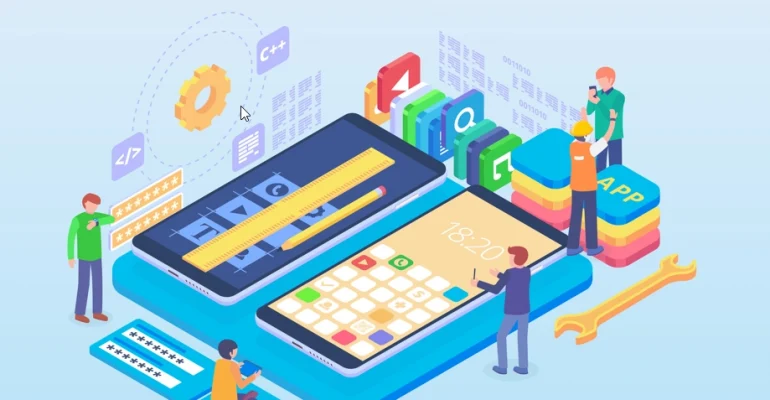Mobile App Development Process – A Guide to Get Your Idea Working

Mobile App Development Process – A Guide to Get Your Idea Working
Smartphones made the businesses available on everyone’s hand. Confused? Anyone can buy from your store from any corner of the world, then be it from a mobile application or a website. Having a website is a necessity, but having a mobile application is a smart move to expand your business.
How?
Do you know there are around 7.1 billion smartphone users all over the world? Yes, that’s true.
Of all the eCommerce sales in the U.S.A, the Mobile retail commerce sales had a share of 49.2% in the year 2020, which is expected to rise to 53.9% in 2021.
These two facts are enough to understand the importance of mobile applications. However, there are hundreds of applications launching on the Google and Apple app stores. So, the competition is high. You need to stand out in every aspect of the mobile app development process.
Yes, and to help you with that, we have come up with a step-by-step guide on the apps development process.
Without much delay let’s get moving.
Mobile App Development Process: A Step-By-Step Guide
The process of developing an app is overwhelming. But, if you move step-wise or at least know the process, then it will be an easy task. You can also opt for the Mobile app development service from a well-known IT company in the market.
There are seven stages of app development, from ideation to its designing and testing. Let’s see how it goes!
1. The Ideation
Ideation is the very first step in building anything, be it a mobile application or a house. You must have an idea of what your app will look like, what it will provide the users, how it is better than only having a website, and much more.
Here are few questions that will help you in creating an idea for the app:
- What is the aim of your app? Is it just selling, spreading awareness, or anything else?
- Who is your target audience? What kind of application will make them happy?
- What will your mobile storefront look like?
- What are your targeted platforms? Android, iOS, or a hybrid?
- What will be the budget?
- When do you want to launch the app?
- How will you promote it?
2. Create a Strategy
Once you have the idea in your hand, the next step is to form a strategy. This is where your idea will transform into a real-life project. Make a strategy that is robust and long-lasting. Here you will do the competitor research and have most of the information on the document.
Creating a strategy needs a lot of research, especially for the mobile applications development process. Why? There are chances of you encountering hundreds of similar apps in the store. As we said, you will have to stand out to gain popularity among the users.
Hence, there is a need of defining the use cases and capturing detailed functional requirements, either from the competitor or your website. Understand the customer’s behavior when they visit your online store.
3. Do the Planning
One of the most critical app development process steps – Planning. Strategy converts the idea into a real project and planning gives it the shape. If you pass these two stages with utmost perfection, you are halfway to successful mobile app development.
There are three things you need to plan at this stage:
Roadmap: Decide how the app design and development process will go, from its vision, mission, and monetization to product features and time frame.
Structure: If there is a problem related to resources, time-frame, or budget, you can also launch the MVP (minimum-viable-product) at first.
Team: Without a team, your project will always stay on the papers. Create or hire an app development team keeping in mind the product you want. Hire an Android developer for the Android app and an iOS developer for the iOS app, as both have different tech stacks.
4. UI/UX Designing of Mobile Application
Until now it was all about strategizing and planning, here comes the real deal – UI (User Interface) and UX (User Experience) designing. Both UI and UX play an important role in mobile application designing, where one holds up the visitor and the other improves its experience.
To provide your customers with the best experience always define the following pointers ahead of time:
User Journey: The user journey depicts the flow of the user on the mobile app, which will represent its user experience. What data will be displayed on the app, what data will be collected, and the app’s navigation. Which click will take the user where!
Wireframe: It is a rough sketch of the application. You can also consider wireframes and app layouts as low-fidelity mockups. The wireframe will focus more on the aesthetics and user experience in its conceptual layouts.
Style Guide: A style guide is a document with details on app functions and UI elements. It will describe the font family the app will use, color schemes, and the brand reflection in the mobile application.
Mockups: Mockups are where the wireframe and style guide meet each other. To be exact, it is the direct visual representation of the mobile application. Once you are at the mockup rounds, be ready for the changes in workflow, aesthetics, and even information architecture.
“Adobe Photoshop and Sketches are the two most popular platforms for mockups used by mobile app developers.”
Prototype: Prototypes help you to experience the working of the mobile application. At this stage, you will be able to click on the buttons and navigate through the application to check whether it is up to the mark.
“Invision and Figma are the two most popular click-thru prototype tools.”
5. Mobile App Development Process
Once you clear the above step, the development stage will start. The mobile app development stage includes a lot of coding and revisions. The mobile app development process has three integral parts: Backend/Server Technology, API (Application Programming Interface), and Mobile App Front-End.
Whether you are planning an on-demand app development or normal app development, always hire the best mobile app developers for the growth of your business.
6. Testing
As soon as you go past all the app development stages, there’s a step called testing. It is also one of the important stages of the mobile app development process. Why? This will reveal how smoothly and efficiently the app works.
The mobile app testing consists of:
- Functionality Testing
- Security Testing
- Performance Testing
- Manual Testing
- Automated Testing
If your application passes all these tests, then congratulations, you have successfully developed a mobile application.
7. Deployment and Launch
Last but not least, the mobile app development process is the deployment and launch. Be ready with your back-end deployment for publishing the apps on different app stores for downloading. Once you have launched the application, make sure you are adding a proper title, description, and necessary information keeping keywords in mind. Don’t forget to add the App’s Screenshot for a clear picture of your application.
This is not the end!
Yes, this isn’t the end of the mobile app development process. It is an ongoing process with its maintenance and support. Every application needs an update at a certain point in time – this is where the maintenance and support come in the scenario.
As we said, a successful app development process is all about the perfect team. Opt for Infigic’s mobile app development service. Here at Infigic, we have highly skilled mobile application developers for Android, iOS, and even the Hybrid app.











